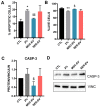Mesenchymal Stem Cell-Derived Extracellular Vesicles Protect Human Corneal Endothelial Cells from Endoplasmic Reticulum Stress-Mediated Apoptosis
- PMID: 34066474
- PMCID: PMC8125791
- DOI: 10.3390/ijms22094930
Mesenchymal Stem Cell-Derived Extracellular Vesicles Protect Human Corneal Endothelial Cells from Endoplasmic Reticulum Stress-Mediated Apoptosis
Abstract
Corneal endothelial dystrophy is a relevant cause of vision loss and corneal transplantation worldwide. In the present study, we analyzed the effect of mesenchymal stem cell (MSC)-derived extracellular vesicles (MSC-EVs) in an in vitro model of corneal dystrophy, characterized by endoplasmic reticulum stress. The effects of MSC-EVs were compared with those of serum-derived EVs, reported to display a pro-angiogenic activity. MSC-EVs were able to induce a significant down-regulation of the large majority of endoplasmic reticulum stress-related genes in human corneal endothelial cells after exposure to serum deprivation and tunicamycin. In parallel, they upregulated the Akt pathway and limited caspase-3 activation and apoptosis. At variance, the effect of the serum EVs was mainly limited to Akt phosphorylation, with minimal or absent effects on endoplasmic reticulum stress modulation and apoptosis prevention. The effects of MSC-EVs were correlated to the transfer of numerous endoplasmic reticulum (ER)-stress targeting miRNAs to corneal endothelial cells. These data suggest a potential therapeutic effect of MSC-EVs for corneal endothelial endoplasmic reticulum stress, a major player in corneal endothelial dystrophy.
Keywords: corneal dystrophy; corneal endothelium; exosomes.
Conflict of interest statement
The authors declare no conflict of interest.
Figures







Similar articles
-
Extracellular Vesicles Derived from Human Umbilical Cord Mesenchymal Stromal Cells Protect Cardiac Cells Against Hypoxia/Reoxygenation Injury by Inhibiting Endoplasmic Reticulum Stress via Activation of the PI3K/Akt Pathway.Cell Transplant. 2020 Jan-Dec;29:963689720945677. doi: 10.1177/0963689720945677. Cell Transplant. 2020. PMID: 32864999 Free PMC article.
-
Extracellular Vesicles Derived from Wharton's Jelly Mesenchymal Stem Cells Prevent and Resolve Programmed Cell Death Mediated by Perinatal Hypoxia-Ischemia in Neuronal Cells.Cell Transplant. 2018 Jan;27(1):168-180. doi: 10.1177/0963689717738256. Cell Transplant. 2018. PMID: 29562785 Free PMC article.
-
Human Umbilical Cord Mesenchymal Stem Cells Protect against Renal Ischemia-Reperfusion Injury by Secreting Extracellular Vesicles Loaded with miR-148b-3p That Target Pyruvate Dehydrogenase Kinase 4 to Inhibit Endoplasmic Reticulum Stress at the Reperfusion Stages.Int J Mol Sci. 2023 May 17;24(10):8899. doi: 10.3390/ijms24108899. Int J Mol Sci. 2023. PMID: 37240246 Free PMC article.
-
Therapeutic prospects of MicroRNAs carried by mesenchymal stem cells-derived extracellular vesicles in autoimmune diseases.Life Sci. 2021 Jul 15;277:119458. doi: 10.1016/j.lfs.2021.119458. Epub 2021 Apr 6. Life Sci. 2021. PMID: 33831424 Review.
-
Extracellular Vesicles from Human Adipose-Derived Mesenchymal Stem Cells: A Review of Common Cargos.Stem Cell Rev Rep. 2022 Mar;18(3):854-901. doi: 10.1007/s12015-021-10155-5. Epub 2021 Apr 26. Stem Cell Rev Rep. 2022. PMID: 33904115 Free PMC article. Review.
Cited by
-
Exosomes and autophagy in ocular surface and retinal diseases: new insights into pathophysiology and treatment.Stem Cell Res Ther. 2022 May 3;13(1):174. doi: 10.1186/s13287-022-02854-8. Stem Cell Res Ther. 2022. PMID: 35505403 Free PMC article. Review.
-
A Combined Procedure of Intrastromal Corneal Rings Explantation and Penetrating Keratoplasty in a Patient With Keratoconus: A Case Report.Front Med (Lausanne). 2022 Mar 11;9:853702. doi: 10.3389/fmed.2022.853702. eCollection 2022. Front Med (Lausanne). 2022. PMID: 35360745 Free PMC article.
-
Adipose Mesenchymal Stem Cell-Derived Exosomes Promote the Regeneration of Corneal Endothelium Through Ameliorating Senescence.Invest Ophthalmol Vis Sci. 2023 Oct 3;64(13):29. doi: 10.1167/iovs.64.13.29. Invest Ophthalmol Vis Sci. 2023. PMID: 37850944 Free PMC article.
-
The Interplay Between Metabolites and MicroRNAs in Aqueous Humor to Coordinate Corneal Endothelium Integrity.Ophthalmol Sci. 2023 Mar 16;3(3):100299. doi: 10.1016/j.xops.2023.100299. eCollection 2023 Sep. Ophthalmol Sci. 2023. PMID: 37125267 Free PMC article.
-
Secondary Mechanisms of Neurotrauma: A Closer Look at the Evidence.Diseases. 2022 May 23;10(2):30. doi: 10.3390/diseases10020030. Diseases. 2022. PMID: 35645251 Free PMC article. Review.
References
-
- Okumura N., Kitahara M., Okuda H., Hashimoto K., Ueda E., Nakahara M., Kinoshita S., Young R.D., Quantock A.J., Tourtas T., et al. Sustained activation of the unfolded protein response induces cell death in Fuchs’ endothelial corneal dystrophy. Investig. Ophthalmol. Vis. Sci. 2017;58:3697–3707. doi: 10.1167/iovs.16-21023. - DOI - PubMed
MeSH terms
Substances
Grants and funding
LinkOut - more resources
Full Text Sources
Research Materials

